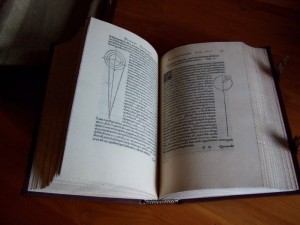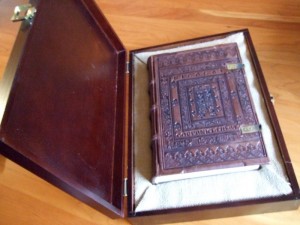One of the “Books that Changed the World” is De Revolutionibus Orbium Coelestium (On the Revolution of Heavenly Spheres). It is a book written by one of the central figures of the Scientific Revolution, Nicolas Copernicus (1473-1543). His book was published in 1543 in Nuremberg and a copy was delivered to Copernicus only when he was on his deathbed. Some say he delayed publication for fear of prosecution, since the conclusions Copernicus reached from his celestial observations supported a heliocentric structure of the universe and conflicted with the Aristotelian/Ptolomeic model that for centuries had been accepted by both secular and Church authorities.
It is thought that 400-500 copies of Copernicus’ book were originally printed. Some 250 copies of that first edition still survive and are in the possession of many of the Great Libraries of the World. The fact that so many copies exist is testament, perhaps, to two things: (1) that those libraries which obtained first edition copies, knowing the highly controversial theories it proposed, kept it out of general circulation, and preserved it more carefully than other volumes; (2) that long after the Scientific Revolution reached its peak in the 19th and 20th Centuries, De Revolutionibus was still considered important reading and took on an iconic status.
 Page Spread |
 Presentation Box |
Just a few minutes up the road from the City of Toruń, Poland, where Copernicus was born, is the City of Pelplin. Today, Pelplin is home to a tight group of craftsmen who not only possess a knowledgeable appreciation of the art and craft of past bookmaking, but apply the most modern technological tools to preserve their historical knowledge and reproduce beautiful simulacra volumes.
In 2008, the Bernardinum Press in Pelplin, accordingly, produced and published a faithful and—as collector’s editions go—quite affordable facsimile of the original first edition printing. Using high-resolution digital photography, each and every page of the original edition in the collection of the Pelplin Library was photographed and optimized for printing. The resulting image files were used to created direct-to-press stochastic printing, and the images of each page were printed on special mould-made paper having the same color, texture, and weight of the paper used in Nuremburg almost 500 years ago.
The binding is also reproduced carefully in a leather that is embossed with the same elaborate design as the one Copernicus held in his hands when it was handed to him. There are two leather clasps to hold the volume closed. And the book is cradled in a cherry-wood colored presentation box, stamped on the lid.
The facsimile is available for purchase for friends of Great Libraries of the World, for USD$3,000. Allow a minimum of six weeks for delivery, and place an order at GLOW’s store.